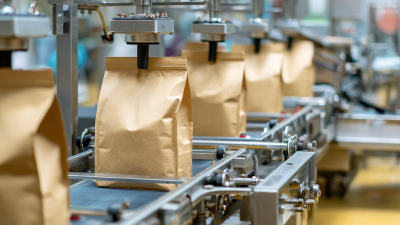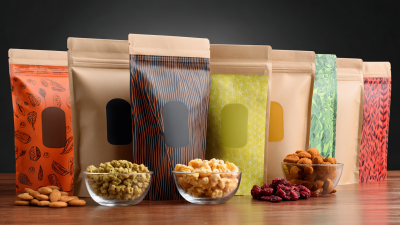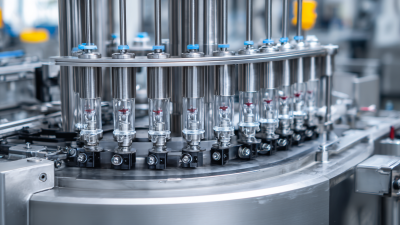Maximize Efficiency: The Role of Bag Filling Machines in the $25 Billion Packaging Industry
In the ever-evolving $25 billion packaging industry, efficiency and productivity are paramount for businesses striving to meet consumer demands and remain competitive. One technology that has revolutionized the packaging process is the bag filling machine. These sophisticated devices are designed to streamline the filling of bags with a variety of products, from food items to industrial materials, ensuring precision, speed, and reduced labor costs. As companies increasingly prioritize operational efficiency and sustainability, understanding how to effectively integrate and utilize bag filling machines becomes essential. This guide will explore the critical features, benefits, and best practices associated with bag filling machines, providing insights on how to maximize their impact on production efficiency and profitability within the packaging sector. By leveraging the capabilities of these machines, businesses can enhance their workflow, minimize waste, and ultimately deliver superior value to their customers.

Understanding the Packaging Industry Landscape: Key Trends and Opportunities
In the ever-evolving landscape of the $25 billion packaging industry, key trends are shaping the future, with bag filling machines playing a pivotal role. Companies increasingly prioritize automation and efficiency to keep up with rising consumer demands and the competitive market. Innovations in bag filling technology not only improve production speed but also enhance precision, ensuring a higher quality of packaged goods.
Tip: Consider integrating smart technology into your bag filling machinery. This can provide real-time data analysis, enabling quicker adjustments and minimizing downtime, ultimately leading to increased productivity.
Sustainability is another vital trend within the packaging sector. As consumers become more environmentally conscious, businesses are exploring eco-friendly materials and processes. Investing in bag filling machines that accommodate biodegradable or recyclable materials can significantly enhance a brand's reputation and appeal.
Tip: Evaluate the lifecycle of your packaging materials. Opt for suppliers and machinery that prioritize sustainability, which can lead to cost savings and a competitive edge in a market increasingly driven by ecological awareness.

The Importance of Bag Filling Machines: Enhancing Precision and Speed in Packaging
 In the $25 billion packaging industry, bag filling machines play an indispensable role in enhancing both precision and speed during the packaging process. According to a report by Smithers Pira, the global packaging market is expected to grow by approximately 3.5% annually, necessitating more efficient operations to keep up with this rising demand. Bag filling machines streamline the packaging process, allowing manufacturers to increase output while maintaining consistent quality. This efficiency is crucial as companies face pressures to reduce costs and meet tight delivery schedules.
In the $25 billion packaging industry, bag filling machines play an indispensable role in enhancing both precision and speed during the packaging process. According to a report by Smithers Pira, the global packaging market is expected to grow by approximately 3.5% annually, necessitating more efficient operations to keep up with this rising demand. Bag filling machines streamline the packaging process, allowing manufacturers to increase output while maintaining consistent quality. This efficiency is crucial as companies face pressures to reduce costs and meet tight delivery schedules.
Moreover, the integration of advanced technologies into bag filling machinery, such as AI and automation, significantly improves precision in filling weights. A study by the Food Processing Association indicates that automated bag filling processes can reduce filling errors by up to 10%, ensuring that products meet regulatory standards and minimizing waste. By enhancing both speed and accuracy, modern bag filling machines empower companies to optimize their workflows, reduce production downtime, and ultimately improve their bottom lines in a highly competitive market.
Types of Bag Filling Machines: Choosing the Right Equipment for Your Operations
When selecting bag filling machines for your operations, it is essential to consider the specific needs of your packaging process. There are several types of bag filling machines available, each designed to handle different products and bag styles. For instance, volumetric fillers are ideal for free-flowing products like grains and powders, while weigh fillers provide accuracy for bulkier items, ensuring that each bag meets weight specifications.
Additionally, you might encounter gravity feeders and auger fillers, which suit various kinds of materials. Gravity feeders excel with lightweight and fluffy substances, while auger fillers are perfect for powdered or granulated materials that require more controlled filling. Understanding the nature of your products and the required speed and efficiency will guide your choice. Investing in the right type of bag filling machine can boost productivity and reduce waste, ultimately contributing to the overall success of your packaging operations in the competitive market.
Maximize Efficiency: The Role of Bag Filling Machines in the $25 Billion Packaging Industry
| Type of Bag Filling Machine | Key Features | Typical Applications | Estimated Cost ($) |
|---|---|---|---|
| Semi-Automatic Bag Filling Machine | Requires manual intervention, versatile | Food products, chemicals | 10,000 - 30,000 |
| Automatic Bag Filling Machine | High-speed operation, minimal human interaction | Bulk materials, granular products | 50,000 - 150,000 |
| Form-Fill-Seal Machines | Fills bags and seals in one operation | Snacks, pet food, pharmaceuticals | 100,000 - 300,000 |
| Volumetric Cup Fillers | Precise volume control, easy adjustment | Powdered products, granules | 15,000 - 50,000 |
Maximizing ROI: How Upgrading Your Bag Filling Technology Can Boost Efficiency
In today's competitive packaging industry, maximizing return on investment (ROI) is crucial for businesses aiming to thrive. Upgrading bag filling technology can significantly enhance operational efficiency and streamline production processes. Advanced bag filling machines are designed to provide precise filling, reducing material waste and minimizing errors. By automating repetitive tasks, these machines contribute to faster production cycles, allowing companies to meet increasing market demands without compromising quality.
Moreover, modern bag filling solutions often come equipped with smart technology that allows for real-time monitoring and adjustments. This capability enables businesses to analyze performance metrics and optimize workflows, further boosting efficiency. With the ability to handle various bag sizes and types, upgraded systems can adapt to changing product lines, making them a valuable investment for future growth. In essence, by focusing on technological advancements in bag filling, companies can not only improve their operational efficiency but also enhance their overall profitability in the lucrative packaging sector.
Maximize Efficiency: Bag Filling Machine Technology Impact on Packaging Industry
The bar chart illustrates the efficiency levels of different types of bag filling machines used in the packaging industry. As technology progresses from standard to high-speed machines, the efficiency level significantly increases, showcasing the importance of investing in advanced bag filling technology for maximizing productivity and ROI.
Innovative Trends in Bag Filling Automation: Future-Proofing Your Packaging Process
The packaging industry, a colossal $25 billion sector, is witnessing transformative shifts driven by innovative trends in bag filling automation. As companies seek to enhance efficiency and meet ever-growing consumer demands, advanced machinery is at the forefront of this evolution. Recent advancements in technology are setting new standards, ensuring that packaging processes are not only faster but also safer and more reliable.
A notable example of this trend is the introduction of high-speed filling machines adept at handling a variety of products, including ready-to-use syringes. These machines can fill up to 400 syringes per minute, demonstrating just how far automation has come in increasing production capacity and minimizing human error. This leap in efficiency is crucial for manufacturers aiming to future-proof their packaging processes, as it allows them to meet market demands swiftly while maintaining quality. By embracing such innovative solutions, businesses position themselves competitively in a rapidly evolving market landscape.
Related Posts
-

Maximizing ROI on Best Bag Filling Machines Through Superior After Sales Support and Maintenance Savings
-

How to Revolutionize Your Brand with Innovative Flexible Packaging Solutions
-

Unveiling the Advantages of Innovative Flexible Packaging Solutions for Modern Businesses
-

Exploring the Future of Best Flexible Packaging Trends and Market Insights for 2025
-

The Future of Liquid Packaging Machines: Innovations Driving Efficiency and Sustainability in 2025
-

How to Choose the Right Liquid Filling Machine for Your Business Needs

